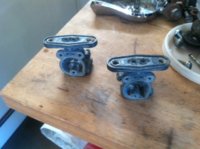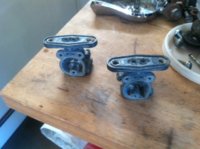griennehornette
XS650 Enthusiast
I dragged my neglected 77D out of the back of the garage after 11 years, and started working on it. My first attempt to get it started several weeks ago ended with a puddle of gas on the floor of my garage. Since then, I cleaned the petcocks and carbs, ordered rebuild kits for the petcocks (along with a bunch of other stuff) and slowly got it back together.
Today, I once again held my breath, poured some gas into the tank hoping to try firing it up... and there's another big puddle of gas on my garage floor.
It was not hard to see it pouring out the petcocks. Like, how can it leak out so fast? Even without gaskets, I would think the metal parts screwed tightly together would at least slow it to a drip, drip, drip. But no; it gushes out in quite the little stream. By the time I quit cursing, grabbed my tools and lifted the tank off, 90% of it had drained out. I don't get it.
The rebuild kit gaskets for the back plates were very thin, compared to the old ones I had. Like they were cut from a garbage bag thin. But still; should that really matter?
It was hard to tell; gas might have been leaking from other places, too. Actually, I hope it was, given the volume pouring out.
Gonna try re-using the old gaskets, which are thicker. I managed to remove them without tearing. Also gonna hit the hardware store for a variety of sizes of hex bolts. The Philips screw was designed by a sadist, intent on causing great frustration for millions of people. Why it is so widely used is really beyond me. I dunno if I can find hex bolts which fit everything. But at least I should be able to get little bitty ones to torque down the face plate with On, Off and Res. It's not that tight as I'm paranoid of stripping the delicate little philips heads. The bolts joining the petcocks to the tank are stripped badly; hoping I can find that size, too. The 3 screws holding the back plate on are tapered, so they might be more challenging to replace.
Anyhoo. Typing this was soothing. I feel less like either giving up, or hunting down the inventor of philips head screws with a pair of pliers and a soldering iron. Therefore, any replies are purely bonus. That said, I'll happily and gratefully receive any advice tossed my way... or simply degrading comments about the philips head screw ;-)
Today, I once again held my breath, poured some gas into the tank hoping to try firing it up... and there's another big puddle of gas on my garage floor.
It was not hard to see it pouring out the petcocks. Like, how can it leak out so fast? Even without gaskets, I would think the metal parts screwed tightly together would at least slow it to a drip, drip, drip. But no; it gushes out in quite the little stream. By the time I quit cursing, grabbed my tools and lifted the tank off, 90% of it had drained out. I don't get it.
The rebuild kit gaskets for the back plates were very thin, compared to the old ones I had. Like they were cut from a garbage bag thin. But still; should that really matter?
It was hard to tell; gas might have been leaking from other places, too. Actually, I hope it was, given the volume pouring out.
Gonna try re-using the old gaskets, which are thicker. I managed to remove them without tearing. Also gonna hit the hardware store for a variety of sizes of hex bolts. The Philips screw was designed by a sadist, intent on causing great frustration for millions of people. Why it is so widely used is really beyond me. I dunno if I can find hex bolts which fit everything. But at least I should be able to get little bitty ones to torque down the face plate with On, Off and Res. It's not that tight as I'm paranoid of stripping the delicate little philips heads. The bolts joining the petcocks to the tank are stripped badly; hoping I can find that size, too. The 3 screws holding the back plate on are tapered, so they might be more challenging to replace.
Anyhoo. Typing this was soothing. I feel less like either giving up, or hunting down the inventor of philips head screws with a pair of pliers and a soldering iron. Therefore, any replies are purely bonus. That said, I'll happily and gratefully receive any advice tossed my way... or simply degrading comments about the philips head screw ;-)






